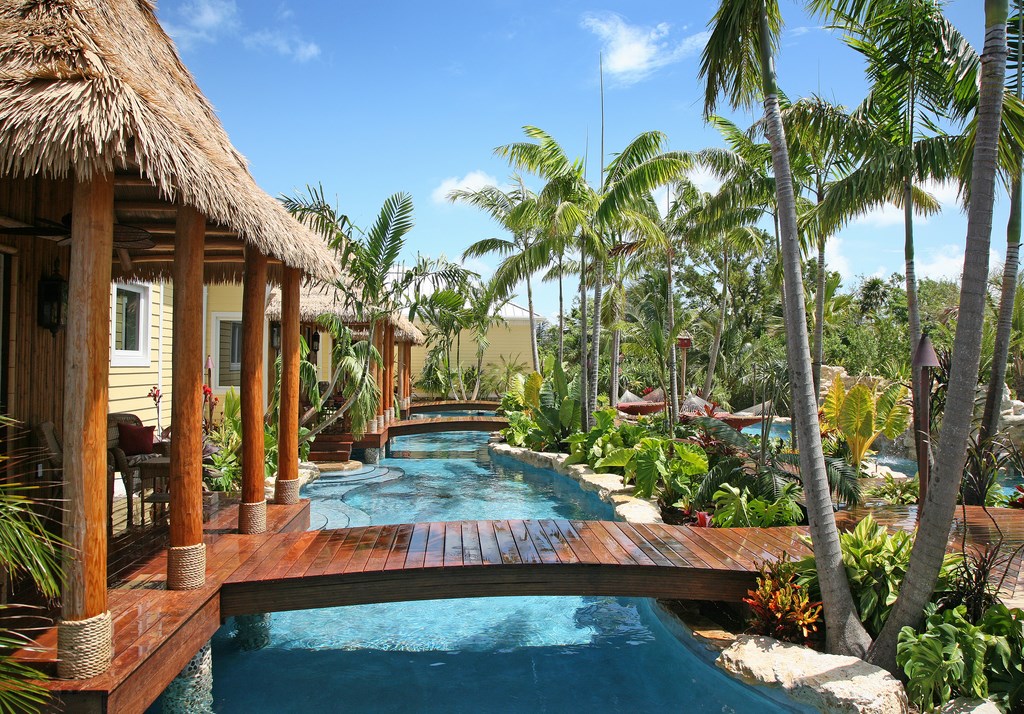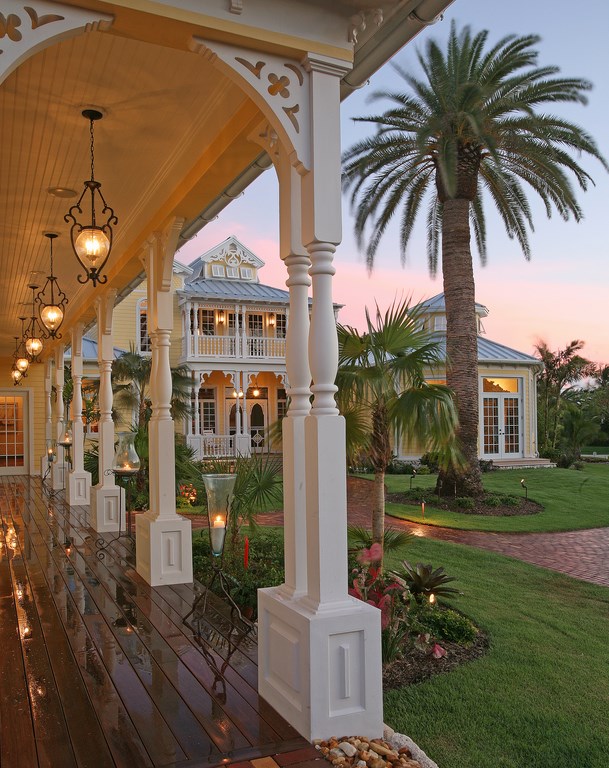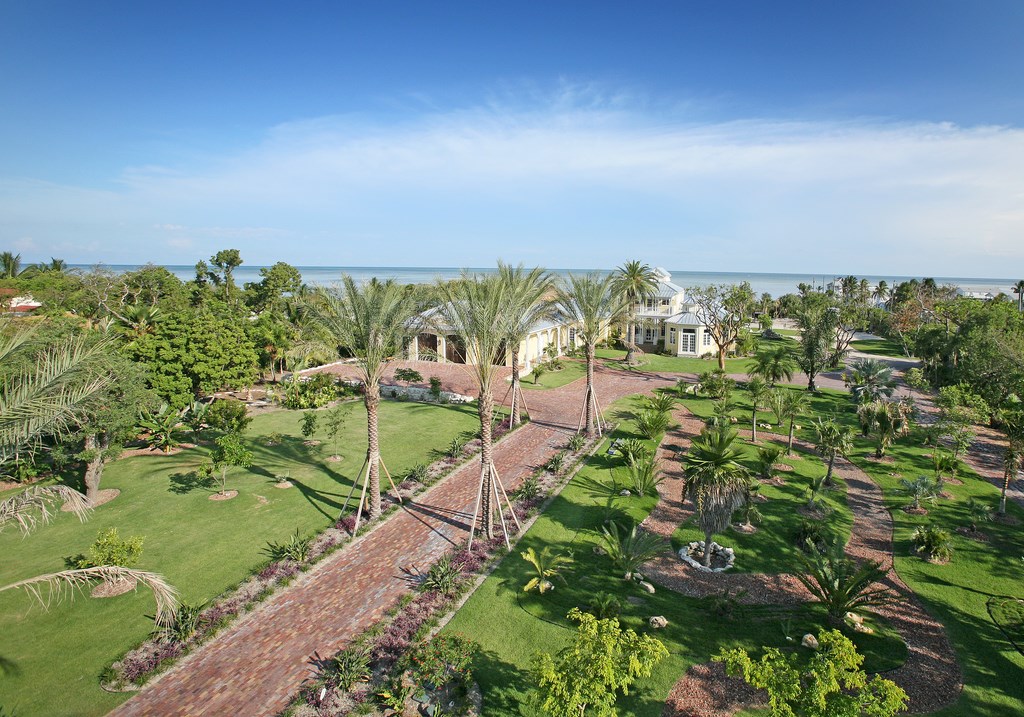Latitude for Attitude

Unlike most companies that become deeply involved in exterior environments, we at D’Asign Source of Marathon, Fla., are also happy to get involved in designing and building everything else associated with a given property.
When asked by our clients to do so, we tackle it all, from designing and engineering a home and taking care of all the licensing and construction, to furnishing the interiors and providing luxurious details inside and out. And when we’re done, we’ll happily service
and maintain the property for them.
The clients we worked with on the project depicted here are a perfect example of how this works. They had bought another estate we had created and were so happy with the results that they called us in when it was time to assemble their dream home on a large seaside parcel in the Florida Keys.
While not all of our projects are so comprehensive, it’s always our preference to take on every aspect of a project for our clients because it gives us the ability to create environments that are clearly integrated into a unified design program. We’ve also found that there are significant logistical and financial benefits to this kind of arrangement, both for our firm and for our clients.
WALLS TO WATER
In this case, we couldn’t have asked for a better situation. First of all, the clients are wonderful people who, through our history together, have become good friends. Second, they’re young, fun-loving and can afford everything they might want – and don’t mind sharing what they have with family and friends. Third – and perhaps most important – they have a passion for the relaxed, water-oriented lifestyle of the Florida Keys that fits perfectly with our capabilities.
Our involvement with them this time began at the earliest possible point. In fact, we even helped them locate the perfect piece of oceanfront property – at five acres an unusually large parcel for the Keys. From that point on, our involvement was total as we worked to uncover the possibilities offered by the site and worked with the clients to determine how they intended to use the space.
| The main house has a distinctly Victorian styling that didn’t exactly mesh with the relaxed spirit that would mark structures on the rest of the property, but we bridged the gap by repeating soft colors and by using the same wood from the home’s porches to create pathways and bridges that play prominent visual roles on the “Keys side” of the composition. |
Right away, they let us know that this was to be their primary residence and was to serve as a base of operations for all sorts of water-related activities – fishing, boating, scuba diving, spear fishing and swimming. It was also destined to be used for entertaining on a large scale, counterbalanced by a similar desire for intimate spaces they could enjoy in private moments. In a nutshell, what they wanted was a Keys-style paradise.
After numerous conversations and site visits, we started working with the primary features, including the main house, a detached guest house complex and a coach house that would serve a variety of utilitarian purposes – mostly as storage space for a variety of aquatic “toys.”
We also began mapping out various garden spaces, including a rainforest, a “Jurassic” garden, an exotic fruit garden and more. We also developed plans for an enormous swimming pool, a large pond for fly-fishing, an outdoor entertainment area that would be known as “The Tiki Village” and a structure called “The Bait Shack,” which, as its name suggests, was to house tanks filled with live bait along with gear for fishing and diving.
Evidencing the owners’ whimsical attitude, they later decides to name the entire estate “The Bait Shack” – humorously ironic, given the lavish nature of the place.
Part of our challenge in all this was figuring out ways to create these disparate functional areas while integrating them all in some sort of coherent design scheme, especially in visual terms. As our work became more specific, of course, we found that this would be no simple task.
Take the main house, for example. At about 6,000 square feet, it’s not terribly large for an estate of this scope, but it was to have a pronounced Victorian style that wouldn’t mesh all that easily with some of the other elements of the project. Helpfully, that style is not uncommon among older homes in the area, so it fit in architecturally, but it isn’t a look that immediately lends itself with creating the sort of South Seas atmosphere our clients were interested in conjuring for their guests.
DUAL APPROACH
To make it work, we had to accept the fact that what we were doing would have a split personality: The home and its interiors were to be replete with all sorts of traditional Victorian detailing, while the guest suites and the exterior spaces in general would capture the rustic, island feel.
Once that path was chosen, it was a matter of devising visual transitions that would bring the two approaches together. The solution in this case was to link the guest house to the main house via raised wood decks and bridges over a canal-like portion of the swimming pool. By controlling the pace and visual dimensions of this transition, we managed to bring the two worlds together in a reasonably effective, harmonious way.
For their part, the three suites that make up the guest house are nothing short of idyllic. Inside, they’re appointed with gorgeous woodwork and open-air tropical details, and each has access to the pool as well as to a deck cantilevered over the water. Each suite is also connected to a large island reached by the bridges.
That island, surrounded by canal-like arms of the pool and heavily planted with palms and other tropical landscaping native to the south seas , features all sorts of waterfalls, pathways, private seating areas and a variety of lighting and fire effects.
| The three guest suites fully embody the Keys atmosphere, with their rustic porches and appearance over canals of a sort that are common features of the local landscape. Each one has a bridge leading to a palm- and hammock-strewn island and the main pool beyond: Made with Ipé and supported by cast-in-place concrete columns, the graceful spans are meant to conjure memories of other tropical environment in which such bridges are used to traverse lagoons and inland waterways. |
Obviously, a project such as this is an enormous undertaking: On both the design and construction sides, we had to organize our activities as major phases – an approach dictated in part by complex permit requirements as well as strict environmental regulations.
In other words, we may have had a site plan, but we knew that once we were started, it was more than likely that some unforeseen design details would take shape as we rolled along. By phasing the process, we added a measure of flexibility that enabled us to cope with whatever local agencies might toss in our direction.
We began by demolishing an existing house and then scraping the site clean. With the canvas blank, we started on the main house, then moved on to the guest quarters and then the swimming pool, which was to function as a primary, unifying element that would weave its way through a number of different areas.
As the work on the structures and pool moved along, we managed to get to some basic landscaping work, but for the most part we stuck to the phase-by-phase program and only worked on “future” phases only when it was both sensible and practical. (Actually, it was hard to resist working on several phases simultaneously, because the clients wanted everything done within an 18-month span. That’s a short stretch for a project as complex and detail-oriented as this one, and I’m convinced it would have been impossible had we not done everything ourselves.)
From the first day, the property was a beehive of activity, often with hundreds of craftspeople and workers on site. Even though the lot was big, we were all amazed at how quickly the space filled up with equipment, materials and hard-working bodies.
DIGGING IN
One of the biggest challenges we faced in this project had to do with all the work we did below grade.
The site is located on ancient reef rock covered by about a foot of sandy soil. Coral rock is extremely porous, so, of course, the water table here is quite high. As a result, we began by installing a mass-scale dewatering system and a series of temporary retention ponds made necessary by the fact that you’re not allowed to dump the water back into the ocean.
| When the homeowners and their guests arrive, they’re introduced to the property’s aquatic themes by a large stone cascade. This waterfall feeds a 150-foot-long stream that eventually flows into a 100-by 80-foot gunite pond stocked with red fish, snapper, puffer fish, tripletail and a few small sharks. |
With that system in place, the basic foundation work involved jack-hammering a complex set of trenches and footings that coursed through the entire property. But those were minor tasks compared to swimming pool excavation and making way for a 110,000-gallon cistern to be used for water reclamation and irrigation.
The cistern, which is buried beneath the guest quarters, is an environmental measure made unusually necessary (and valuable) by the scarcity of freshwater resources in the area. Driven by a computer, the system distributes precise amounts of water to the various garden areas, all based on prevailing weather conditions and the defined irrigation needs of different plants.
Digging out such large areas gave us substantial quantities of rocky spoils we used to build up portions of the lot and raise the main house five feet above grade. We also used this excavated material as the underpinnings for a large stone waterfeature at the front of the house. Broken coral has a certain charm, but we also imported hundreds of tons of more decorative stone for use throughout the property.
From the start, it was everyone’s intention that the pool would provide big fun and dazzle just about anyone who might see it. In many ways the pool is really the heart of the entire design because of the way it links and integrates so many contrasting spaces and the various activities they support.
And it’s big: At about 220 feet long and 50 feet wide, it boasts 8,000 square feet of surface area and holds 225,000 gallons. Approximately 80 percent of the pool is four feet deep, but there’s also an area in front of the grotto that’s up to ten feet deep and offers ample opportunities for jumping and diving from various locations.
The idea was to create a backyard pool that would rival what even the best resorts have to offer. We’d even say it surpasses most of those wonderful pools by virtue of the way it embraces the structures and brings the homeowners and their guests right up to the water.
On one side, there’s a 200-foot-long leg of the pool that flows by both the main house and the guest quarters. It has the feel of a canal and is therefore typical of waterways found all over the Keys, but it one-ups them by having decks that reach out over the water as well as swim-outs. In addition, we physically linked all of the patio and island features together tropical-wood bridges to make it, all in all, a wonderful, interconnected place to be.
ZONED FOR FUN
The long canal ultimately flows into a broad swimming area marked by extensive rock edging, a large beach entrance and a 20-person spa. To one end of this area is the abovementioned grotto, which includes waterfalls, a swim-up area and diving rocks. Adjacent to this area is a large swim-up bar – a key part of the original plan’s “Tiki Village” – and a beach entry over near the spa.
The grotto is constructed entirely of natural stone – Fort Meyers Cap Rock – chosen to match similar stone we brought in for use around the rest of the property. We suspended the grotto’s interior stones on a steel armature, then covered the structure with a concrete shell that served to support the boulders we placed atop the cavern.
| The pool is truly the heart of the entire estate’s design. Divided into a variety of fun zones – canals, a deep jumping and diving well with a slide, a 20-person spa, a large beach entry, a play area, a grotto and more – the area also includes ‘Tiki Village,’ a space that includes a large circular swim-up bar with eight underwater stools as well as a host of outdoor cooking/bar amenities and an overhead structure designed to resist hurricane-force winds. |
The pool is a typical gunite structure, but much of it is raised above the natural grade in order to match the levels set for the main and guest houses. (We used excavated coral rock to bring much of area around the pool up to the new grade.) The pool is finished with a custom quartz product from 3M (St. Paul, Minn.) whose color has been dubbed, appropriately enough, “Bait Shack Blue.”
The water is sanitized using a saltwater chlorinator, but unlike most systems of this kind, we decided here to exploit an abundant resource by using filtered seawater to fill and maintain the pool’s huge volume.
In keeping with the rest of the property, the pool is functionally divided into a variety of zones. The portion that flows by the main house and guest suites has, as previously suggested, a canal-like appeal and stands ready for swimming, wading or observing the beauty of the pool’s island. Over in the main pool area, by contrast, the accent is on more vigorous play as well as group activities courtesy of the spa, the swim-up bar, the grotto, the diving rocks, the beach entry and the volleyball court set up just beyond the beach entrance.
This watershape is so big with so many distinct spaces that the owners have devised an unusual aquatic game in which they and their guests use underwater scooters to race around a course that stretches out for some 500 feet in length. It’s all about fun, in other words, and the owners and their guests have taken to all of the available amenities like ducks to water.
The result is an estate of unusual luxury, whimsy and variety. Through it all, our clients were wonderful collaborators who placed a great deal of confidence in our firm by allowing us to make a large number of critical decisions, both technical and aesthetic.
For my part, I’ve had the pleasure of visiting the property on a social basis on several occasions since we completed our work on site, and I’ve been thrilled to see how much the clients and their other guests enjoy the various environments. Our firm has executed lots of elaborate projects through the years, but few have reached the level or the sheer fun of The Bait Shack.
Franco D’Ascanio is co-owner and operator of D’Asign Source, a diversified family-owned and -operated firm in Marathon, Fla., that engages in home design and construction, interior design, landscape architecture and construction, watershaping, nursery and stone-supply services and audio/visual system design and installation. He runs the company, which was established by his parents in 1960,with his brothers Anthony (in charge of construction) and Amedeo (who handles the architectural department). At first, the company’s range was limited to the stone-supply operation, but before long it moved into residential design and construction mostly for upscale clients in the Florida Keys. Among the company’s many claims to fame, it boasts a nursery with one of the most comprehensive selection of palm species in the United States.















